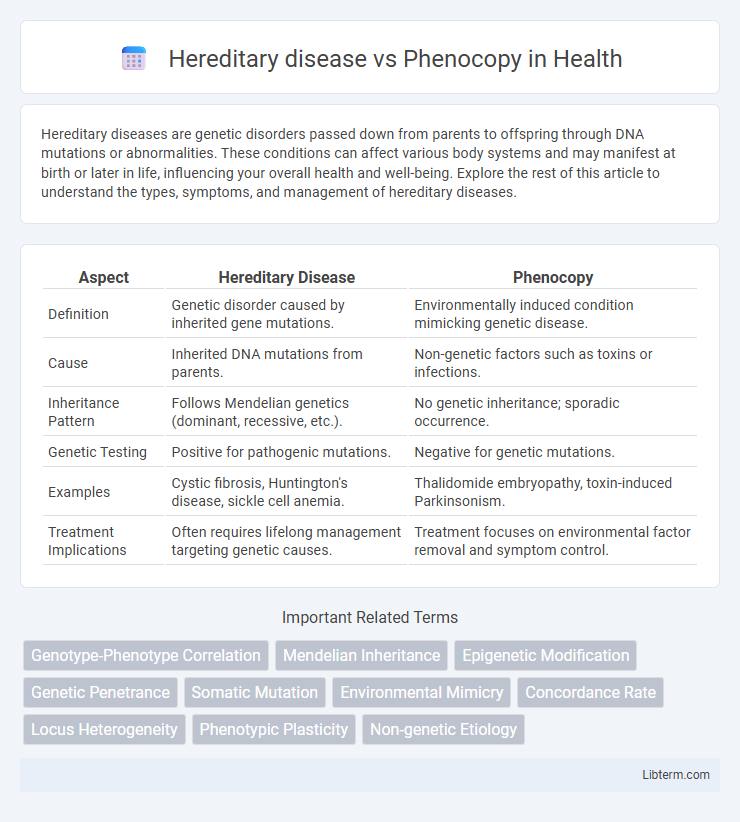Hereditary diseases are genetic disorders passed down from parents to offspring through DNA mutations or abnormalities. These conditions can affect various body systems and may manifest at birth or later in life, influencing your overall health and well-being. Explore the rest of this article to understand the types, symptoms, and management of hereditary diseases.
Table of Comparison
| Aspect | Hereditary Disease | Phenocopy |
|---|---|---|
| Definition | Genetic disorder caused by inherited gene mutations. | Environmentally induced condition mimicking genetic disease. |
| Cause | Inherited DNA mutations from parents. | Non-genetic factors such as toxins or infections. |
| Inheritance Pattern | Follows Mendelian genetics (dominant, recessive, etc.). | No genetic inheritance; sporadic occurrence. |
| Genetic Testing | Positive for pathogenic mutations. | Negative for genetic mutations. |
| Examples | Cystic fibrosis, Huntington's disease, sickle cell anemia. | Thalidomide embryopathy, toxin-induced Parkinsonism. |
| Treatment Implications | Often requires lifelong management targeting genetic causes. | Treatment focuses on environmental factor removal and symptom control. |
Introduction to Hereditary Diseases and Phenocopies
Hereditary diseases are genetic disorders passed from parents to offspring through mutations in DNA, often following Mendelian inheritance patterns such as autosomal dominant or recessive traits. Phenocopies are conditions that mimic hereditary diseases in clinical presentation but arise from environmental factors or non-genetic causes without underlying genetic mutations. Understanding the distinction between hereditary diseases and phenocopies is crucial for accurate diagnosis, genetic counseling, and tailored treatment strategies.
Defining Hereditary Diseases
Hereditary diseases are genetic disorders caused by mutations in specific genes passed from parents to offspring, resulting in inherited traits or conditions such as cystic fibrosis or sickle cell anemia. These diseases are characterized by predictable inheritance patterns, including autosomal dominant, autosomal recessive, X-linked, or mitochondrial inheritance. Unlike phenocopies, which mimic genetic disorders due to environmental factors without underlying genetic mutations, hereditary diseases are rooted in the individual's genetic code.
Understanding Phenocopy: Key Concepts
Phenocopy occurs when environmental factors induce traits that mimic hereditary diseases without altering the genetic code, distinguishing it from true genetic mutations. Understanding phenocopy involves recognizing its role in phenotypic variation, where non-genetic influences replicate inherited disease symptoms. This concept is critical in differentiating genuine genetic disorders from environmental imitations for accurate diagnosis and treatment.
Genetic vs Environmental Influences
Hereditary diseases originate from genetic mutations passed through generations, reflecting inherited DNA variations that directly influence disease development. Phenocopies arise due to environmental factors mimicking genetic disorders, where external influences such as toxins or infections produce symptoms identical to those caused by specific genetic mutations. Understanding the interplay between genetic predisposition and environmental triggers is crucial for accurate diagnosis and effective treatment strategies in complex disease presentations.
Mechanisms Underlying Hereditary Diseases
Hereditary diseases arise from genetic mutations passed from parents to offspring, affecting DNA sequences that disrupt normal cellular functions and protein production. These mutations can be inherited in dominant, recessive, or mitochondrial patterns, leading to altered gene expression, loss of function, or gain of toxic function in critical biological pathways. Phenocopies mimic hereditary disease phenotypes but result from environmental factors or external influences without underlying genetic mutations, highlighting the importance of distinguishing inherited genetic mechanisms from environmental causes in diagnosis and treatment.
Mechanisms Behind Phenocopies
Phenocopies result from environmental factors that mimic genetic diseases without altering the DNA sequence, often through epigenetic modifications or external influences such as toxins, infections, or nutritional deficiencies. These mechanisms disrupt normal gene expression or protein function, producing clinical phenotypes identical to those caused by inherited mutations. Understanding phenocopy pathways aids in distinguishing genetic disorders from environmentally induced conditions, crucial for accurate diagnosis and personalized treatment strategies.
Diagnostic Challenges: Hereditary Disease vs Phenocopy
Hereditary diseases often present diagnostic challenges due to their genetic mutations and family history patterns, which require precise genetic testing for accurate identification. Phenocopies mimic hereditary conditions clinically but arise from environmental factors or sporadic mutations, complicating differential diagnosis without genetic confirmation. Distinguishing between hereditary disease and phenocopy is crucial for appropriate treatment and genetic counseling, necessitating comprehensive molecular diagnostics and detailed patient histories.
Clinical Implications and Patient Management
Hereditary diseases result from genetic mutations passed down through families, requiring genetic counseling and targeted testing for accurate diagnosis and management. Phenocopies mimic hereditary conditions but arise from environmental factors or non-genetic causes, necessitating different clinical approaches such as lifestyle modification and symptom-based treatment. Differentiating between hereditary disease and phenocopy is essential for risk assessment, personalized treatment plans, and informing family members about potential genetic risks.
Examples and Case Studies
Hereditary diseases such as cystic fibrosis and Huntington's disease are caused by genetic mutations passed from parents to offspring, while phenocopies mimic these conditions without a genetic basis, often resulting from environmental factors or infections. For example, phenocopies of phenylketonuria occur in cases of maternal metabolic disorders during pregnancy, demonstrating similar metabolic disturbances without inheritable mutations. Case studies reveal that distinguishing hereditary diseases from phenocopies is crucial for accurate diagnosis and treatment, as seen in instances where environmental toxins induce symptoms resembling genetic disorders.
Future Directions in Research and Diagnosis
Future research in hereditary diseases emphasizes advanced genetic sequencing technologies and AI-driven predictive modeling to enhance early diagnosis and personalized treatment. Phenocopy investigations focus on identifying environmental triggers and epigenetic factors that mimic genetic disorders, aiming to refine diagnostic criteria and differentiate between true genetic mutations and environmental influences. Integrating multi-omics data and machine learning will improve precision medicine approaches, allowing more accurate prognosis and targeted therapies for both hereditary diseases and phenocopies.
Hereditary disease Infographic

 libterm.com
libterm.com